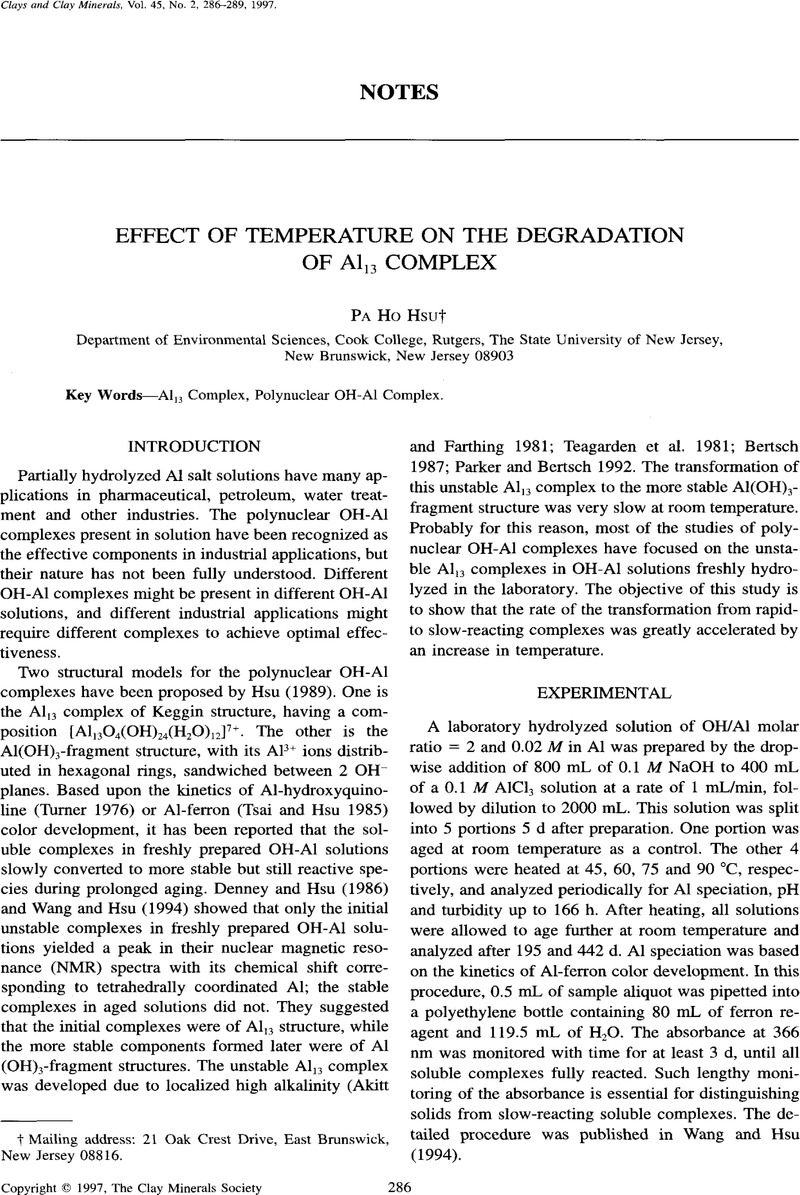Crossref Citations
This article has been cited by the following publications. This list is generated based on data provided by Crossref.
Gerardin, Corine
Haouas, Mohamed
Lorentz, Chantal
and
Taulelle, Francis
2000.
NMR quantification in hydrothermalin situ syntheses.
Magnetic Resonance in Chemistry,
Vol. 38,
Issue. 6,
p.
429.
Allouche, Lionel
Gérardin, Corine
Loiseau, Thierry
Férey, Gérard
and
Taulelle, Francis
2000.
Al30: A Giant Aluminum Polycation.
Angewandte Chemie,
Vol. 112,
Issue. 3,
p.
521.
Volzone, C.
and
Garrido, L. B.
2001.
Retention of OH-Al complexes by dioctahedral smectites.
Clay Minerals,
Vol. 36,
Issue. 1,
p.
115.
Taniguchi, Satoru
Hiradate, Syuntaro
and
Sakurai, Katsutoshi
2001.
Speciation of hydroxyaluminosilicate and hydroxyaluminum ions as affected by the presence of montmorillonite: Extraction experiment with potassium chloride and speciation by27Al-NMR.
Soil Science and Plant Nutrition,
Vol. 47,
Issue. 2,
p.
333.
Allouche, L
Huguenard, C
and
Taulelle, F
2001.
3QMAS of three aluminum polycations: space group consistency between NMR and XRD.
Journal of Physics and Chemistry of Solids,
Vol. 62,
Issue. 8,
p.
1525.
Allouche, Lionel
and
Taulelle, Francis
2003.
Fluorination of the ε-Keggin Al13polycation.
Chem. Commun.,
p.
2084.
Yamaguchi, Noriko U.
Hiradate, Syuntaro
Mizoguchi, Masaru
and
Miyazaki, Tsuyoshi
2003.
Formation and disappearance of Al tridecamer in the presence of low molecular weight organic ligands.
Soil Science and Plant Nutrition,
Vol. 49,
Issue. 4,
p.
551.
Wang, Shan Li
Wang, Ming K
and
Tzou, Yu Min
2003.
Effect of temperatures on formation and transformation of hydrolytic aluminum in aqueous solutions.
Colloids and Surfaces A: Physicochemical and Engineering Aspects,
Vol. 231,
Issue. 1-3,
p.
143.
Kuan, Wen Hui
Wang, Ming Kuang
Huang, Pan Ming
Wu, Chia Wen
Chang, Chia Ming
and
Wang, Shan Li
2005.
Effect of citric acid on aluminum hydrolytic speciation.
Water Research,
Vol. 39,
Issue. 15,
p.
3457.
Chen, Zhaoyang
Luan, Zhaokun
Fan, Jinghua
Zhang, Zhongguo
Peng, Xianjia
and
Fan, Bin
2007.
Effect of thermal treatment on the formation and transformation of Keggin Al13 and Al30 species in hydrolytic polymeric aluminum solutions.
Colloids and Surfaces A: Physicochemical and Engineering Aspects,
Vol. 292,
Issue. 2-3,
p.
110.
Ye, Changqing
Wang, Dongsheng
Shi, Baoyou
Ge, Xiaopeng
and
Qu, Jiuhui
2007.
Formation and transformation of Al13 from freshly formed precipitate in partially neutralized Al(III) solution.
Journal of Sol-Gel Science and Technology,
Vol. 41,
Issue. 3,
p.
257.
Lin, Ya-Fan
and
Lee, Duu-Jong
2010.
Electrospray Mass Spectrometry Studies of Purified Aluminum Tridecamer in a 50:50 Water/Acetonitrile Mixture.
The Journal of Physical Chemistry A,
Vol. 114,
Issue. 10,
p.
3503.
Wei, XUE
and
Shao-yong, LU
2015.
Effects of inactivation agents and temperature on phosphorus release from sediment in Dianchi Lake, China.
Environmental Earth Sciences,
Vol. 74,
Issue. 5,
p.
3857.



